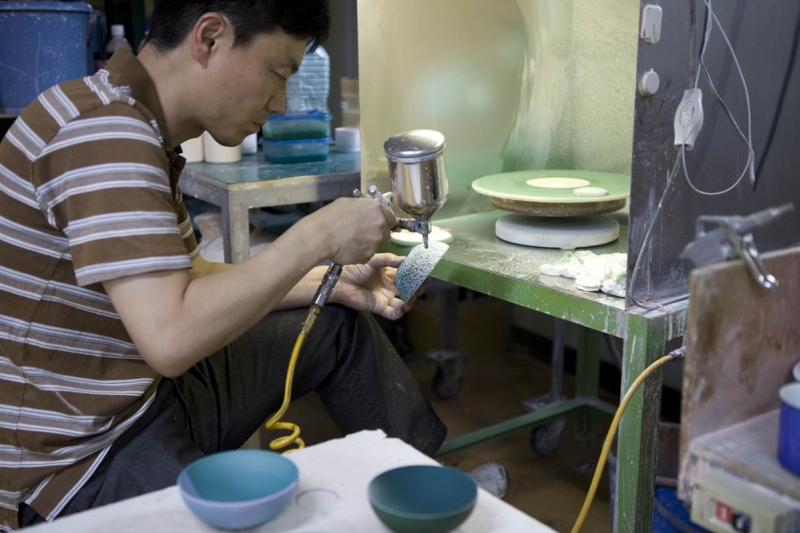Interview: Studio Wieki Somers
Dylan van den Berg and Wieki Somers studied at the Design Academy Eindhoven before establishing the Studio Wieki Somers in Rotterdam. Together they are known for producing sensitive and intriguing works that are described as ‘an enlightened reading' of the everyday environment’. For 2016/ they have produced two tea sets that subvert traditional techniques and materials in wholly original ways.
- Your collection for 2016/ focuses on the decorative quality of the iconic Koransha blue glaze. When did you develop the idea to abstract this traditional technique?
Two things at the Koransha pottery struck us; the deep blue colour that is typical and the metal wire stencils that Koransha use to decorate the ceramics. The stencils reminded us of the gold decoration used in the 18th century to upgrade exported porcelain goods. The stencils expose white areas beneath the glaze, like a memory of something that was once there. To make a more contemporary product we translated these stencils in an abstract way. Instead of the traditional metal stencils we used parts of the actual porcelain products, such as the cup’s handle or the lid of the teapot, to mask the glaze, creating strong abstract patterns on the vessels. Coincidentally, these patterns are reminiscent of one of the most iconic Japanese symbols: the moon, as are the dominant sphere shapes found in the tea set.
- Can you explain a little about the process of working with the glaze: was the technique difficult to master?
We made many samples in our studio by spraying paint onto paper models of cups with folded handles, pots with removable lids, stacked plates, etc. We asked the craftsmen at Koransha to do the same exercise. When we had achieved the perfect pattern we made it digital and used transfers for the flat shapes, these are a more efficient production technique used very skillfully by the Koransha craftsmen.
- How were your experiences of Arita? What aspects of the place and the people did you find especially interesting?
In the summer of 2014 we visited almost all the factories and workshops involved in the 2016/ project. It was interesting to see that each factory had it’s own techniques and specialties and that these professional skills and knowledge are now shared amongst each other. It was especially inspiring to see the refinement of the porcelain in many factories. We also made a trip to Hirado, not far from Arita, to research the history of the 400 year-old trade relations between The Netherlands and Japan. There we attended a traditional tea ceremony. That experience completed the research for our project.
- How does the project reflect your studio's work? Are there any aspects of your design that you think are typical of how you work and approach projects?
Koransha and our studio are a good match. Koransha has a very high standard, and we are also very demanding in our work. We both combine traditional crafts and advanced technology such as 3D Printing in our production methods. We like to show the beauty of the production process, celebrate the craft, in our designs. There are often hidden meanings to be discovered in our work, and that is also true of this project. What we found especially interesting about Japanese design was that decoration often delivers meaning; decoration instigates conversation and discussion over a cup of tea.
- How do you see your tea sets being used? Are they intended for everyday use or are they precious pieces to be enjoyed as part of a tea drinking ritual?
Ideally we see the tea sets being used every day (although they may be popular items for use during ‘Tsukimi’, the moon viewing festival). And we hope the tea sets might inspire an interpretation of the tea ceremony outside of Japan too.
Photography by Anneke Hymmen










